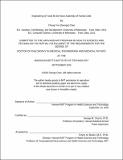| dc.contributor.advisor | George M. Church,. | en_US |
| dc.contributor.author | Chao, Chung-Yun(Chung-Yun George) | en_US |
| dc.contributor.other | Harvard--MIT Program in Health Sciences and Technology. | en_US |
| dc.date.accessioned | 2021-03-22T17:20:26Z | |
| dc.date.available | 2021-03-22T17:20:26Z | |
| dc.date.copyright | 2020 | en_US |
| dc.date.issued | 2020 | en_US |
| dc.identifier.uri | https://hdl.handle.net/1721.1/130205 | |
| dc.description | Thesis: Ph. D. in Medical Engineering and Medical Physics, Harvard-MIT Program in Health Sciences and Technology, September, September, 2020 | en_US |
| dc.description | Cataloged from student-submitted PDF version of thesis. | en_US |
| dc.description | Includes bibliographical references. | en_US |
| dc.description.abstract | Organs for transplantation has continuously been in short supply and, given COVID-19's propensity to adversely impact solid organs, the shortage will likely become exacerbated. For decades, the field of tissue engineering has developed innovative methods to generate model tissues de novo. Top-down approaches, such as microfluidics and 3D bioprinting, provide spatial control by patterning cell types with high resolution, but face challenges in reproducing physiologically accurate cell types and interactions. Bottom-up methods, such as organoids, induce pluripotent cells to differentiate into aggregates that resemble their in vivo counterparts, yet the size and complexity of these structures are limited by nutrient diffusion and the morphology cannot be controlled. An ideal system would allow for high spatial control while retaining native cell-cell interactions formed through developmental progression. | en_US |
| dc.description.abstract | To approach this capability, we aimed to create a sequential gene expression system that programmatically aggregate and differentiate cells, merging both top-down and bottom-up characteristics. First, we curated and characterized 28 recombinases to determine efficiency and pairwise compatibility for use in mammalian recombinase genetic circuits (RGC). From this set, we designed an RGC capable of expressing 12 genes in sequence, providing a framework for simulating the gene expression cascades of development. To elucidate the temporal dynamics of recombinase action in mammalian cells, we formulated a mathematical model for recombinase expression and catalysis and validated it with experimental data. We found that recombinases have variable expression levels, catalytic rates, and binding affinities, which should be accounted for when designing RGCs. | en_US |
| dc.description.abstract | Separately, we designed a platform for engineering novel membrane proteins for inducing specific cell-cell interactions using coiled-coils, called helixCAM. We demonstrated that helixCAMs are capable of inducing patterned cell binding in E. coli, yeast, and human cells, and further utilized a library-on-library approach to engineer new helixCAM-optimized coiled-coils. Taken together, the genetic tools described in this thesis establish groundwork towards hybrid tissue engineering strategies capable of high-resolution patterning while enabling endogenous cell differentiation and cell-cell interactions to form, ultimately serving as a template for engineering large-scale tissue and organs de novo. | en_US |
| dc.description.statementofresponsibility | by Chung-Yun (George) Chao. | en_US |
| dc.format.extent | 221 pages | en_US |
| dc.language.iso | eng | en_US |
| dc.publisher | Massachusetts Institute of Technology | en_US |
| dc.rights | MIT theses may be protected by copyright. Please reuse MIT thesis content according to the MIT Libraries Permissions Policy, which is available through the URL provided. | en_US |
| dc.rights.uri | http://dspace.mit.edu/handle/1721.1/7582 | en_US |
| dc.subject | Harvard--MIT Program in Health Sciences and Technology. | en_US |
| dc.title | Engineering of tools for De Novo Assembly of Human Cells | en_US |
| dc.type | Thesis | en_US |
| dc.description.degree | Ph. D. in Medical Engineering and Medical Physics | en_US |
| dc.contributor.department | Harvard University--MIT Division of Health Sciences and Technology | en_US |
| dc.identifier.oclc | 1241253033 | en_US |
| dc.description.collection | Ph.D.inMedicalEngineeringandMedicalPhysics Harvard-MIT Program in Health Sciences and Technology | en_US |
| dspace.imported | 2021-03-22T17:19:56Z | en_US |
| mit.thesis.degree | Doctoral | en_US |
| mit.thesis.department | HST | en_US |
